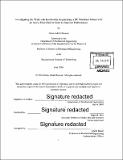Investigating the trade-offs involved in augmenting a DC brushless motor with an active heat sink in order to improve performance.
Author(s)
Browne, Deron Adriel
DownloadFull printable version (4.456Mb)
Other Contributors
Massachusetts Institute of Technology. Department of Mechanical Engineering.
Advisor
Hugh M. Herr.
Terms of use
Metadata
Show full item recordAbstract
This thesis seeks to establish solutions to the issue of electric motor heating and the problems it presents for use of these motors in biomechatronic applications. As electric motors are used, their windings heat up and the resulting temperature limits torque. Larger motors may be used to obtain more torque, but this adds undesirable weight to the devices in which they are used. Cooling methods also exist, but do not necessarily consider suitability to bionic applications. This thesis therefore aims to improve the torque output of a given motor by effectively removing heat while minimizing the addition of mass. I hypothesize that the torque density of an EC-4 pole 30 48V Maxon DC brushless motor can be improved by augmenting it with an electronics fan and an annulus. Results showed that the housing to ambient thermal resistance of the motor was decreased by 68% from the experimentally found value of 11.5KW-3 to a value of 4.03KW- 3 by using a 4.72 x 10- 3 m3s-1 (10 cfm rated) electronics fan. The projected torque density of the motor was also found to be maximally improved from 0.382Nmkg-1 to 0.393Nmkg-1. These results were obtained under the assumptions that the motor could be reasonably represented by its brushed counterpart and that parallel plate fluid dynamics closely approximates annular fluid dynamics. While more investigation is necessary to fully validate the results, they do show that there is potential for using simple methods to significantly improve the torque density of small electric motors. It is possible then that added mass can work to noticeably improve motor performance. There is therefore scope to improve the use of these motors in biomechatronic devices. Smaller, more efficient motors will decrease the weight of these devices and improve their overall efficiency. Bionic devices will thus be one step closer to better mimicking human capability.
Description
Thesis: S.B., Massachusetts Institute of Technology, Department of Mechanical Engineering, 2016. Cataloged from PDF version of thesis. Includes bibliographical references (page 53).
Date issued
2016Department
Massachusetts Institute of Technology. Department of Mechanical EngineeringPublisher
Massachusetts Institute of Technology
Keywords
Mechanical Engineering.